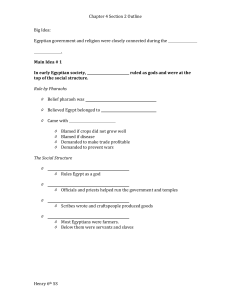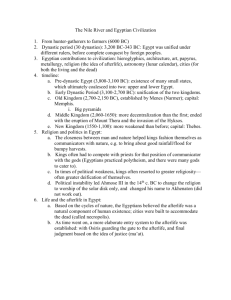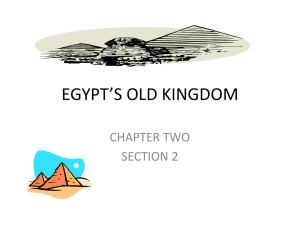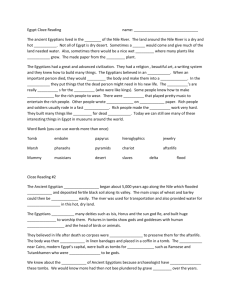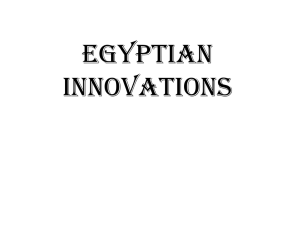SECTION 2 TEXT egypt
advertisement
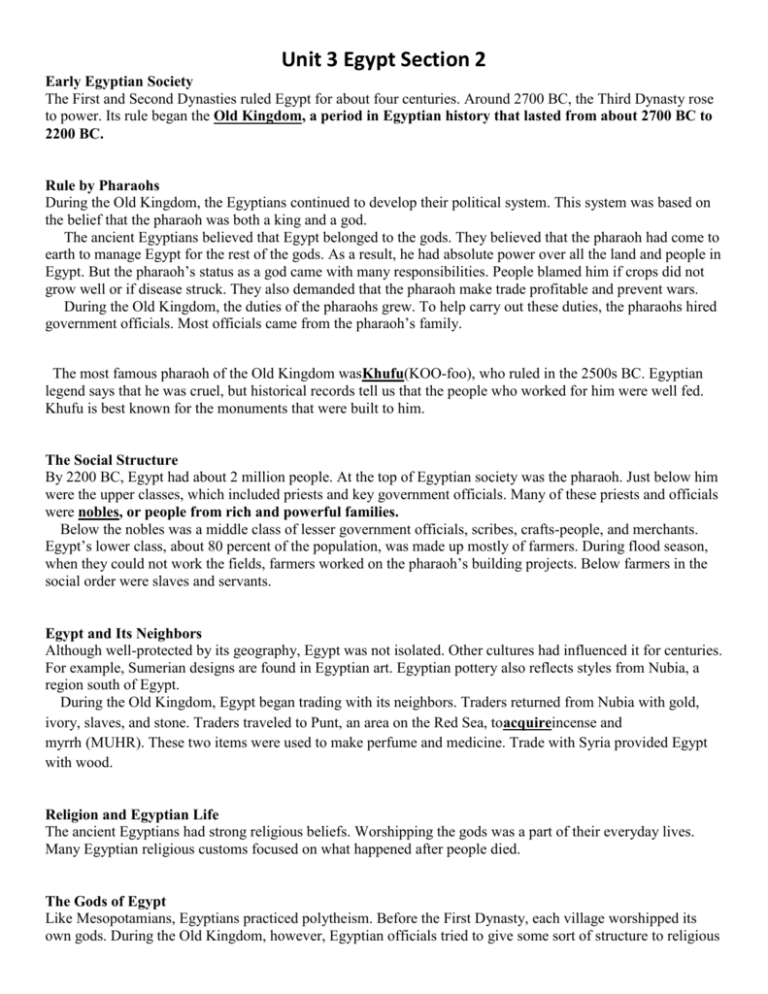
Unit 3 Egypt Section 2 Early Egyptian Society The First and Second Dynasties ruled Egypt for about four centuries. Around 2700 BC, the Third Dynasty rose to power. Its rule began the Old Kingdom, a period in Egyptian history that lasted from about 2700 BC to 2200 BC. Rule by Pharaohs During the Old Kingdom, the Egyptians continued to develop their political system. This system was based on the belief that the pharaoh was both a king and a god. The ancient Egyptians believed that Egypt belonged to the gods. They believed that the pharaoh had come to earth to manage Egypt for the rest of the gods. As a result, he had absolute power over all the land and people in Egypt. But the pharaoh’s status as a god came with many responsibilities. People blamed him if crops did not grow well or if disease struck. They also demanded that the pharaoh make trade profitable and prevent wars. During the Old Kingdom, the duties of the pharaohs grew. To help carry out these duties, the pharaohs hired government officials. Most officials came from the pharaoh’s family. The most famous pharaoh of the Old Kingdom wasKhufu(KOO-foo), who ruled in the 2500s BC. Egyptian legend says that he was cruel, but historical records tell us that the people who worked for him were well fed. Khufu is best known for the monuments that were built to him. The Social Structure By 2200 BC, Egypt had about 2 million people. At the top of Egyptian society was the pharaoh. Just below him were the upper classes, which included priests and key government officials. Many of these priests and officials were nobles, or people from rich and powerful families. Below the nobles was a middle class of lesser government officials, scribes, crafts-people, and merchants. Egypt’s lower class, about 80 percent of the population, was made up mostly of farmers. During flood season, when they could not work the fields, farmers worked on the pharaoh’s building projects. Below farmers in the social order were slaves and servants. Egypt and Its Neighbors Although well-protected by its geography, Egypt was not isolated. Other cultures had influenced it for centuries. For example, Sumerian designs are found in Egyptian art. Egyptian pottery also reflects styles from Nubia, a region south of Egypt. During the Old Kingdom, Egypt began trading with its neighbors. Traders returned from Nubia with gold, ivory, slaves, and stone. Traders traveled to Punt, an area on the Red Sea, toacquireincense and myrrh (MUHR). These two items were used to make perfume and medicine. Trade with Syria provided Egypt with wood. Religion and Egyptian Life The ancient Egyptians had strong religious beliefs. Worshipping the gods was a part of their everyday lives. Many Egyptian religious customs focused on what happened after people died. The Gods of Egypt Like Mesopotamians, Egyptians practiced polytheism. Before the First Dynasty, each village worshipped its own gods. During the Old Kingdom, however, Egyptian officials tried to give some sort of structure to religious Unit 3 Egypt Section 2 beliefs. Everyone was expected to worship the same gods, though how they worshipped the gods might differ from one region of Egypt to another. The Egyptians built temples to the gods all over the kingdom. The temples collected payments from both the government and worshippers. These payments allowed the temples to grow more influential. Over time, certain cities became centers for the worship of certain gods. In Memphis, for example, people prayed to Ptah, the creator of the world. The Egyptians had gods for nearly everything, including the sun, the sky, and the earth. Many gods mixed human and animal forms. For example, Anubis, the god of the dead, had a human body but a jackal’s head. Other major gods included Re, or Amon-Re, the sun god Osiris, the god of the underworld Isis, the goddess of magic, and Horus, a sky god, god of the pharaohs Emphasis on the Afterlife Much of Egyptian religion focused on the afterlife, or life after death. The Egyptians believed that the afterlife was a happy place. Paintings from Egyptian tombs show the afterlife as an ideal world where all the people are young and healthy. The Egyptian belief in the afterlife stemmed from their idea of ka (KAH), or a person’s life force. When a person died, his or her ka left the body and became a spirit. The ka, however, remained linked to the body and could not leave its burial site.The ka had all the same needs that the person had when he or she was living. To fulfill the ka’s needs, people filled tombs with objects for the afterlife. These objects included furniture, clothing, tools, jewelry, and weapons. Relatives of the dead were expected to bring food and beverages to their loved ones’ tombs so the ka would not be hungry or thirsty. Burial Practices Egyptian ideas about the afterlife shaped their burial practices. Egyptians believed that a body had to be prepared for the afterlife before it could be buried. This meant the body had to be preserved. If the body decayed, its spirit could not recognize it. That would break the link between the body and spirit. The ka would then be unable to receive the food and drink it needed to have a good afterlife. To keep the ka from suffering, the Egyptians developed amethodcalled embalming. Embalming allowed bodies to be preserved for many, many years as mummies, specially treated bodies wrapped in cloth. A body that was not embalmed would decay quickly. The Pyramids Egyptians believed that burial sites, especially royal tombs, were very important. As a result, they built spectacular monuments in which to bury their rulers. The most spectacular of all were the pyramids, huge stone tombs with four triangle-shaped walls that met in a point on top. The Egyptians began to build pyramids during the Old Kingdom. Some of the largest pyramids ever constructed were built during this time. Many of these huge structures are still standing. The largest is the Great Pyramid of Khufu near the town of Giza. It covers more than 13 acres at its base and stands 481 feet high. This single pyramid took more than 2 million limestone blocks to build. Historians are still not sure exactly how Egyptians built the pyramids. They are, however, amazing feats of engineering, the application of scientific knowledge for practical purposes. Burial in a pyramid demonstrated a pharaoh’s importance. The size was a symbol of the pharaoh’s greatness. Embalming was a complex process that took several weeks. When finished, embalmers wrapped the body with linen cloths and bandages. The mummy was then placed in a coffin. Relatives often wrote magic spells inside the coffin to help the mummy receive food and drink. Unit 3 Egypt Section 2 Only royalty and other members of Egypt’s elite (AY-leet), or people of wealth and power, could afford to have mummies made. Peasant families buried their dead in shallow graves at the edge of the desert. The hot dry sand and lack of moisture preserved the bodies naturally. The pyramid’s shape, pointing to the skies, symbolized the pharaoh’s journey to the afterlife. The Egyptians wanted the pyramids to be spectacular because they believed that the pharaoh, as their link to the gods, controlled everyone’s afterlife. Making the pharaoh’s spirit happy was a way of ensuring a happy afterlife for every Egyptian.

